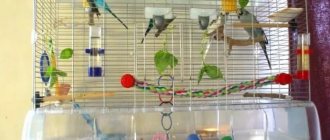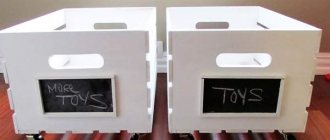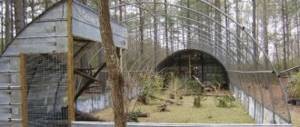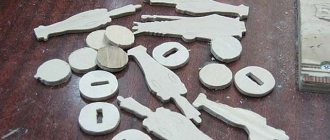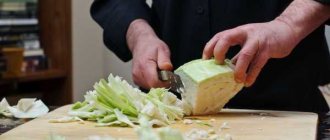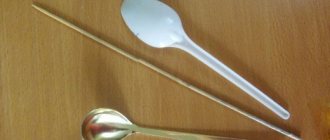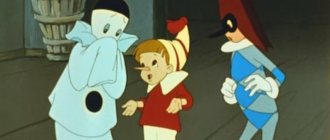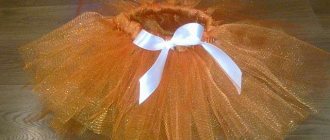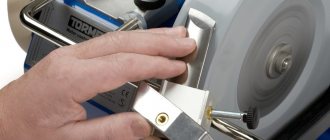Despite the wide selection of cages and aviaries for parrots, it is not always possible to find suitable parameters that will suit you in size, type, and price. The way out of this situation may be to build an aviary for budgies with your own hands.
In this article we will give an example of the construction of a specific small indoor enclosure with dimensions: length - 120 cm; width – 60 cm; height – 102 cm. pallet – 22 cm height.
The frame was made of 30x30mm bars, which were previously cleaned with sandpaper. The bars are fastened with screws and, for greater durability, with metal corners.
The mesh is stretched and nailed using a construction stapler on the inside of the frame, which will protect it from parrots. The sharp edges of the mesh are bent and driven into the frame so that the birds do not get hurt. It should also be noted that it is advisable to choose a mesh made of stainless steel, since a metal mesh can rust, which is not only impractical, but can also harm budgies.
The size of the mesh cells should not exceed 20 mm so that the parrots cannot get out of the enclosure or get stuck between the cells. In this case, a mesh with a cell size of 12.x25 mm was used.
The retractable tray is made of galvanized sheet metal, which makes cleaning the enclosure easy. The pallet was made for me in a tin shop. To make it easier to pull it out, I attached small round handles. For a more aesthetic appearance, the tray has a hinged lid; in addition, when cleaning, the parrots will not be able to get out of the enclosure.
The bottom of the enclosure was made of multilayer plywood 10 mm thick.
The enclosure is bolted together and completely dismountable, which is important when moving or temporarily downtime.
Natural living conditions for parrots are always better than life in captivity. Therefore, a loving owner must do everything to make his pet as comfortable as possible. Today, the most suitable option is an aviary; such housing is suitable for both one parrot and several at once.
We invite you to find out the features of independent construction of such housing for birds, as well as what features it has.
Pros and cons of using parrot aviaries
An aviary for parrots has both positive and negative sides.
- In the warm season, dwellings are placed on a balcony or other open place to please the birds and help them get into their native element.
- The large enclosure creates the illusion of freedom.
- Without a lot of time to communicate with feathered pets, birds will get bored alone. Balcony placement is a great alternative for interacting with other birds.
- Keeping several birds in one enclosure is much more profitable than keeping each bird in a separate cage.
The disadvantages of the aviary include:
- Reducing the amount of free space in your home or apartment.
- If one of the birds gets sick, others may also become infected, which will lead to an epidemic.
- It is very difficult to raise such birds, since in groups they are practically untrainable.
- The breeding process cannot be controlled, nor can it be possible to provide the couples with separate houses and diet.
Suitable location for the cage
Parrots are social animals. They get very bored alone and experience stress if there is little communication with them. Therefore, they should be placed in the room where the owner spends the most time. The cage is placed at human eye level. It is advisable that one or two of its sides are adjacent to the wall - this way the bird will feel protected.
The location of the bird's home should be well lit. It should be exposed to sunlight, but the bird should not be left in the sun for long to avoid overheating. It is forbidden to place the cage on a windowsill, place it in a draft or near heating appliances.
Where is the best place to place an aviary?
Before you start building an enclosure, you need to decide on its location. This should be a place where there is sufficient sunlight. If this is not possible, then the necessary amount of artificial lighting must be provided.
There should also be free access to the structure for cleaning, changing water and feed. If the enclosure is large, it is better to make several pallets at once to make cleaning easier. The enclosure should be such that it can be moved if something happens.
Cleaning the cage
Daily cleaning consists of washing the feeders, drinking bowls, baths and tray with hot water. Dirt is cleaned with a sponge or brush. Once a week, the entire housing is cleaned: the bottom in which the tray stands, the perches and all accessories are cleaned with a sponge or brush, the rods are wiped with a napkin and all items are washed with hot water. Once a month, the home and all accessories are treated with a solution of chamomile, calendula or potassium permanganate for disinfection.
Before placing new items inside, wash them with hot water and pour boiling water over them. During molting, the tray is washed 2 times a day and fallen feathers, which can harbor parasites or bacteria, are removed.
How to make an aviary for parrots with your own hands
After a location has been chosen, you need to make a drawing on paper to avoid mistakes, and also to accurately calculate how much material is needed.
Work begins with the following tools available:
- drill and drill bits;
- stapler, hammer and wire cutters;
- saw, screwdriver;
- sandpaper;
- meter and level.
From building materials you will need:
Net
One of the main issues in making an enclosure is the correct selection of mesh. The ideal option is welded mesh. Its advantage is the simplicity and reliability of fastening on different frames, as well as safety for birds.
The following types of mesh can also be found on sale:
- Made from stainless steel. The safest and most durable. It is rare, but has a price significantly higher than others.
- Galvanized. Despite its durability, it is not entirely safe for birds. However, its general availability and low cost make it popular.
- Iron. It does not pose a threat to health, but a significant drawback is corrosion, which appears under the influence of certain factors. Traces of rust can be ingested by birds after climbing on the netting.
- Metal with plastic coating. This option is not very acceptable. The thickness of the mesh makes it difficult to observe birds normally, as well as full access to light. In addition, since parrots have a tendency to taste everything, they can chew it. And since plastic can be poisonous, the bird can be poisoned.
- Plastic. It is unsuitable because the bird can chew it or get stuck in it.
The mesh is thoroughly washed with a soft brush, wiped with vinegar and dried. You can check the reliability of welding by lightly pressing on individual rods.
Frame
To make the frame, it is better to use bars made from hardwood trees. This is the best option, since parrots love to chew on everything. The tree must be dry. The thickness of the bars is selected depending on the future size of the enclosure. They can be 20x20 mm or 30x30 mm.
Professionals recommend making a collapsible enclosure. So that if something happens, it can be disassembled and transported without problems.
Work on the construction of the frame consists of the following actions:
- Cut the required length on the bars. The cuts should be as even as possible so that the joints have no gaps.
- The wood is cleaned with sandpaper. This will not only make them smoother, but will also give the structure greater aesthetics.
- The bars are fastened together using self-tapping screws. Metal corners are attached to the joints.
- Cut the mesh to the required length and attach it to the walls. This can be done using a construction stapler, which can significantly save time on this work. It is recommended to fill the mesh from the inside of the building, this will reduce the likelihood of damage to the bars by animal beaks.
- The back wall is made of PVC panels; the color can be chosen at your discretion. It is important to do everything to prevent birds from gnawing on them.
Doors
The size and number of doors are calculated based on the following situations:
- One door should allow you to easily enter the enclosure and carry out the necessary manipulations.
- The second door is made to replace food and water in the drinking bowls. Since to maintain cleanliness they are placed at the bottom, a small door should also be located there. You can place them in large doors, making them from ordinary bars, while covering them with mesh.
How to choose a suitable cage for cockatiels
In order to decide on the choice of cage, it is necessary to obtain at least the most general information about the bird for which it is intended.
Did you know? The Corella belongs to the Cockatoo family, not the Parrot family. The Latin name of the bird - Nymphicus hollandicus - reflects the beauty and tenderness of this representative of birds (ancient Greek nymphs are beautiful divine maidens, personifying various life-giving forces of nature). The cockatiel's homeland is Australia, but since 1960 these parrots have been prohibited from being exported from the mainland, so all the birds sold in our pet stores come from birds that were captured in captivity at least half a century ago.
One of the distinctive features of cockatiels is the presence of a contrasting crest on the head. These birds are given elegance and even some sophistication by pointed wings with long flight feathers and an equally long wedge-shaped tail, making up about half the entire length of the parrot. However, it is precisely these features of its structure that must be taken into account when selecting a suitable cell.
Dimensions
A cockatiel's cage should be appropriate for both the size and personality of the parrot.
The body length of an adult can reach 33 cm, the wingspan is 38 cm, which is approximately twice the average size of a budgerigar.
In addition, cockatiels in the wild never settle in tropical thickets, preferring open space to deep forests. It is for this reason that for this species of parrots it is important not just a roomy, but a spacious home (ornithologists note that these birds are actually better kept in aviaries rather than in cages, but in any case you need to strive for the largest possible size of the home, especially if We are talking about several birds).
Important! A cage for a budgie is absolutely not suitable for a cockatiel: it is too small for such a bird.
Experts talk about the following minimum cell sizes:
- length - 60 cm;
- width - 40 cm;
- height - 70 cm.
The main parameter in the cage is not the height, but the length, because the bird does not fly from top to bottom.
Lack of horizontal space can cause your cockatiel to injure its luxurious wings or break its tail. Find out how to choose a cockatiel parrot, what to name it, how to distinguish a boy from a girl in cockatiel parrots.
Form
As you know, cages for parrots can have a round, square or rectangular base. The cylindrical shape of the home looks very beautiful, but in this case the tastes of the owner and his pet do not coincide at all. If there are no corners, parrots feel uncomfortable, disoriented and nervous. In addition, when moving its paws along the curved rods, the bird will constantly slide, which can lead to injury.
The second question that often arises is the direction of the rods. In ready-made cage models, the bars are almost always positioned horizontally, since manufacturers are well aware that this option will allow the parrot to move freely along the walls, clinging to them with its claws and beak. However, models with vertical rods also exist, so when purchasing a product, you must pay attention to this point.
When inspecting the device of the selected model, you should also check whether it has a pull-out tray that can be cleaned without disturbing its occupant. However, if the parrot is given the opportunity to fly freely around the house (and proper care of the cockatiel requires this), you can clean the house while the bird is not in it. In this case, the presence of a pull-out tray is not such an important condition, although removing the tray is still much easier and more convenient than lifting the heavy upper part.
Learn how to care for cockatiels and their chicks.
Material
The material from which the cage is made must meet the following requirements:
- environmental Safety;
- strength;
- smoothness (so that the bird is not injured by sharp edges, corners, protruding objects);
- Possibility of quick cleaning.
From this point of view, wood, beloved by everyone for its naturalness and environmental friendliness, is not suitable as a material for a bird house.
Caring for it is quite complicated, it is heavy, it is inconvenient to wash and clean such material, and in addition, dangerous pests can easily grow in it. It is impossible to treat the boards with special antiparasitic materials - they can cause poisoning in the feathered resident.
Plywood is a lighter material, but it also has its drawbacks. As a valid option, you can consider MDF fiberboard due to its high environmental friendliness or thinner fiberboard.
Important! Chipboard (chipboard) contains a lot of formaldehyde resins, which are hazardous to bird health, and oriented strand board (OSB) is even less suitable for making cages. It should be noted that in the West there are two standards for chipboard - more and less safe from an environmental point of view. However, in Russia this classification is not accepted, so it is still better not to use domestic chipboard.
Nevertheless, such materials are only suitable for a pallet and only in the case of making a home for poultry using a homemade method; however, even in this situation, it is better to use modern chemical industry products - plastic or organic glass.
It is important to make sure that the material is strong enough: a bird is unlikely to be able to damage it, but its owner while cleaning or simply passing by is quite likely to do so.
It would be good if the pallet design included high sides. In this case, the parrot's waste products will not spill out of the cage and spread throughout the house.
Some models provide an additional grid that is placed on top of the tray, preventing the bird from being poisoned by pecking at stale food mixed with its own droppings (this garbage passes through the grid and becomes inaccessible to the parrot).
This will also help keep your bird's feet dry and clean. Many parrot owners do not welcome this design, believing that the cockatiel can be injured by the horizontal bars at the bottom of its house, but in reality the likelihood of such an accident is very small, and the advantages are obvious.
As for the walls and roof, it is best to give preference to stainless steel rods or mesh, and the distance between the rods (cells) should be at least 20 mm so that the parrot cannot stick its head through the rods and get injured.
Learn how to make an aviary and carrier for parrots.
What needs to be arranged
To provide the birds with adequate care, you need to carefully consider how to equip the inside of the aviary.
Experts recommend placing the following devices:
When choosing perches, you need to take into account the type of parrot. Their size and quantity should not clutter the house or restrict movement. Ideally, there are only two of them for each bird. One is located near the feeder, and the other is on top of the enclosure.
Since in nature birds constantly climb branches of varying thickness, in captivity they should not be deprived of this either. The perch is made conical on top so that the thickness of one end is 13 cm and the other 2 cm.
It is important that the perches are only wooden; plastic is not suitable in this case. When choosing the thickness, it is important to take into account that the parrot must completely grasp it. Sometimes owners equip enclosures with whole branches of deciduous trees straight from the bark.
Feeders and drinkers must be durable. In addition, they must have fasteners with which they will be attached to the wall of the enclosure. It is better that these devices are made of ceramic or stainless steel.
It is important to ensure that the edges are carefully processed so that the bird does not injure itself on them. The shape of the feeder is not particularly important, but it is better to give preference to a wide one with not very high sides. Place feeders and drinkers near the door so that the bird does not have to be disturbed once again when renewing food or water.
Parrots love different toys, as they are inquisitive and playful birds. Most often, swings, ladders and a mirror are hung in their houses. Their number depends on the size of the enclosure. The planks for swings and ladders should be chosen in the same way as the perches so that the bird does not fall.
Swings and ladders are attached in the middle so that the parrot does not get hurt while playing on the net.
The mirror will become a good friend for the parrot. He will communicate with him and will not get bored while the owner is at work.
The bird will also like bells and other devices that make sounds.
In conclusion, I would like to emphasize that making an aviary with your own hands will not only save money, but will also allow you to create the ideal house specifically for your parrot or parrots. It all depends on how many birds you decide to get.
Parrots of all species need movement to stay healthy. If the bird lives in a small cage, it needs to be let out regularly to fly. A large aviary eliminates this need, and if it is impossible to “walk” the bird in the house, this is the only way out.
Cage requirements
The cage is where the parrot spends most of its time. It must have the appropriate size and shape so that the pet feels comfortable. In addition, the design and materials must be safe for birds.
Dimensions and shape
The size of the cage directly depends on the size of the parrot that will live in it. The minimum housing dimensions for small species (for example, a budgerigar) are 40x25x50 cm (LxWxH). For large individuals, a large cage or enclosure will be required. If you plan to keep several birds together, the dimensions of the housing should be increased in proportion to the number of inhabitants.
The most preferred shape is rectangular. It is convenient to design and assemble, and later to clean and equip with the necessary accessories. You can make a cylindrical cage, but it must be larger than a rectangular one.
Material of manufacture
The roof, walls and door are made of rigid mesh fabric, for example, construction welded steel mesh with a wire thickness of 2-3 mm. Larger species of parrots will require a thicker, stronger guard. The distance between the rods for small birds should not exceed 1-1.5 cm, for large birds - 2 cm.
The bottom is made solid; For ease of cleaning, it is advisable to make a retractable tray. It will require a sheet of plywood 1-1.5 cm thick. To prevent debris in the form of food particles from accumulating around the cage, a side about 10 cm high is installed around the perimeter of the bottom.
Pros and cons of using parrot aviaries
In addition to the fact that it takes up more space compared to a cage, a parrot aviary affects the care of its occupants. Therefore, it is important to study the features of keeping pets in such a home.
What are the benefits of an aviary?
- Thanks to its size, birds feel freer and are more active during the day, which has tangible benefits for their health.
- Parrots are social animals. In a spacious house they can live together, communicate and not suffer from loneliness.
- In warm weather, it is best to keep the enclosure outdoors, and in suitable climates they can even be installed outdoors. Then the birds produce enough vitamin D, their immunity is strengthened, and molting is easier.
- If you have several birds, it is faster to clean and maintain one large cage than many small ones. All pets receive food, supplements and fresh water at once.
- Large parrots cannot be kept in a cramped cage all the time, but an aviary will provide him with personal space and a proper daily routine without unnecessary human intervention.
Where is the best place to place an aviary?
Depending on the location of the cage, the enclosure can be outdoor (garden) or indoor. In a city apartment, it will, of course, take up living space, but with the help of decor and plants it will become an original part of the interior.
The main factor in placing an enclosure is lighting. Light is extremely important for the well-being of pets, and if there is not enough light coming from the sun, then you need to install high-quality lamps.
The cage should not be placed next to household appliances and heating devices. It is also necessary to consider access to it for cleaning and feeding.
It would be good if the enclosure could be disassembled and moved to the balcony. In summer, it is useful for birds to be outdoors and receive the ultraviolet radiation they need from the sun's rays. For the same reason, the best housing option for parrots would be an aviary in the courtyard of a country house. Such living conditions for pets will be as close to natural as possible.
However, for a garden enclosure you will have to carefully consider protection from external dangers: weather conditions and wild animals. Inside you need to arrange a place where the birds will hide from bad weather and direct sunlight. The cage floor must be reinforced to prevent rodents from undermining it.
An outdoor enclosure can be temporary, only for the summer period: in cold weather it is moved into the house. It is possible to keep birds outside all the time, but this requires a heated outbuilding where they will spend the winter.
How to make an aviary for parrots with your own hands
The fastest option, which will suit many people, is to buy a ready-made enclosure in a store. But there is a chance that you will not find the right size that will fit into your interior. In this case, it is better to make an aviary for parrots with your own hands. You yourself will think over its design, taking into account the comfort of your pets, free space in the house, and it will cost less. As a last resort, you can find someone who will make a custom-made cage.
So, first of all, think about where exactly the bird house will be located, and draw a drawing. This will save effort and accurately calculate the amount of materials. The main elements of the cage are the mesh, frame, doors and pallet.
Net
The mesh of the enclosure must be safe for its inhabitants. Caution is required here, because there are different types of mesh on sale, which are not always suitable for use in an enclosure.
- Welded stainless steel is the most harmless and durable option, but relatively expensive.
- Galvanized mesh is potentially harmful, although its low cost and durability mean it is often used in cages.
- Iron nets themselves are not dangerous, but if rust appears, the parrot may accidentally chew it off.
- Plastic-coated metal or pure plastic netting is not suitable for cages because the wires are too thick and block light. In addition, birds easily bite off pieces of plastic, and this can lead to poisoning.
If you decide to go with an affordable galvanized mesh, you must wash it with a sponge under warm water and wipe it with vinegar, after which it must dry.
The recommended mesh size is 15 x 15 mm. The rods should be no thicker than 5 mm.
Frame
For the frame on which the net is supported, solid wooden blocks made from safe wood are usually used, as parrots are more likely to chew on them. At the frame manufacturing stage, it is better to provide the ability to disassemble the enclosure.
The bars are usually chosen in sizes 20 x 20 or 30 x 30 mm. They are cut as evenly as possible so that the joints are tight. To connect the bars, self-tapping screws and mounting angles are used. A mesh of the required size is attached to the finished frame with metal brackets, preferably from the inside, so that the parrots are less likely to peck at the wood.
For every 0.6 m of mesh you need to add a horizontal block to make it stronger. The back wall of the enclosure is often made of PVC - the main thing is that the animals cannot chew it.
Doors
In a large enclosure, two doors are usually installed for different purposes:
- large for cleaning;
- small for access to food and water.
Features of outdoor enclosures
There are several important differences in setting up an open-air bird house. Its area can be any size, but you should not make it too high so that it is easier to catch birds if necessary.
Wild animals carry infections and parasites, so domestic birds are protected from contact with them. Small rodents and predators get inside the cage, making a dig, if the foundation is not laid or the enclosure is not put on legs. For the foundation, a trench 30-40 cm deep is dug in the ground, filled with stones and crushed stone, and then concrete is poured to ground level.
Protection is also needed from birds of prey and other wild birds. To do this, another layer of mesh with a different cell size (40 x 40 or 50 x 50 mm) is stretched from the outside of the cage a few centimeters from the first.
In a garden house, parrots need shelter from heat and rain - a roof or canopy is suitable for this. It would be a good idea to place a bush or tree inside the house: this will provide shade and bring the parrots closer to their native environment. And, of course, don’t forget about the winter quarters.
Another key point in designing an outdoor aviary for birds is the vestibule, otherwise a parrot that accidentally flies out will end up in an open space, which should not be allowed.
